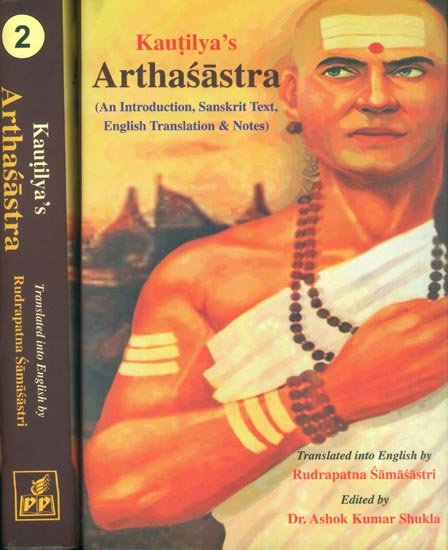Kautilya Arthashastra
by R. Shamasastry | 1956 | 174,809 words | ISBN-13: 9788171106417
The English translation of Arthashastra, which ascribes itself to the famous Brahman Kautilya (also named Vishnugupta and Chanakya) and dates from the period 321-296 B.C. The topics of the text include internal and foreign affairs, civil, military, commercial, fiscal, judicial, tables of weights, measures of length and divisions of time. Original ...
Chapter 20 - Duty towards the Harem
[Sanskrit text for this chapter is available]
On a site naturally best fitted for the purpose, the king shall construct his harem, consisting of many compartments, one [40] with in the other, enclosed by a parapet and a ditch, and provided with a door.
He shall construct his own residential palace after the model of his treasury-house; or he may have his residential abode in the centre of the delusive chamber (mohanagṛha), provided with secret passages made into the walls; or in an underground chamber provided with the figures of goddesses and of altars (caitya) carved on the wooden door-frame, and connected with many underground passages for exit; or in an upper storey provided with staircase hidden in a wall, with a passage for exit made in a hollow pillar, the whole building being so constructed with mechanical contrivance as to be caused to fall down when necessary.
Or considering the danger from his own classmates (sahādhyāyi), such contrivances as the above, mainly intended as safeguards against danger, may be made on occasions of danger or otherwise as he deems fit.
No other kind of fire can bum that harem which is thrice circumambulated from right to left by a fire of human make (mānuśeṇāgnina); nor can there be kindled any other fire. Nor can fire destroy that harem the walls of which are made of mud mixed with ashes produced by lightning and wetted in hail-water (karaka-vāri).
Poisonous snakes will not dare to enter into such buildings as are provided with jīvanti (Fasderia foetida), śveta (Aconitum ferox), muṣkakapuṣpa (?), and vandāka (Epidendrum tesselatum), and as are protected by the branches of pejāta (?) and of aśvattha (Ficus religiosa).
Cats, peacocks, mongooses, and the spotted deer eat up snakes.
Parrots, minas (śārika), and Malabar birds (bhṛṅgarāja) shriek when they perceive the smell of snake poison.
The heron (krauñca) swoons in the vicinity of poison; [41] the pheasant (jīvañjīvaka) feels distress; the youthful cuckoo (mattakokila) dies; the eyes of the partridge (cakora) are reddened.
Thus remedies shall be applied against fire and poison.[1]
On one side in the rear of the harem, there shall be made for the residence of women compartments provided not only with all kinds of medicines useful in midwifery and diseases, but also with well-known pot-herbs (prakhyātasaṃsthāvṛkṣa), and a water-reservoir; outside these compartments, the residences of princes and princesses; in front (of the latter building), the toilet-ground (alaṅkāra bhūmi), the council-ground (mantrabhūmi), the court, and the offices of the heir-apparent and of superintendents.
In the intervening places between two compartments, the army of the officer in charge of the harem shall be stationed.
When in the interior of the harem, the king shall see the queen? only when her personal purity is vouchsafed by an old maid-servant. He shall not touch any woman (unless he is apprised of her personal purity); for hidden in the queen’s chamber, his own brother slew king Bhadrasena; hiding himself under the bed of his mother, the son killed king Kārūśa; mixing fried rice with poison, as though with honey, his own queen poisoned Kāśirāja; with an anklet painted with poison, his own queen killed Vairantya; with a gem of her zone bedaubed with poison, his own queen killed Sauvīra; with a looking-glass painted with poison, his own queen killed Jālūtha; and with a weapon hidden under her tuft of hair, his own queen slew Viḍūratha.[2]
Hence the king shall always be careful to avoid such lurking dangers. He shall keep away his wives from the society of ascetics with shaved head or braided hair, of buffoons, and of outside prostitutes (dāsi). Nor shall women of high birth have occasion to see his wives, except appointed midwives.
Prostitutes (rūpājīvā) with personal cleanliness effected by fresh bath and with fresh garments and ornaments shall attend the harem.
Eighty men and fifty women under the guise of fathers and mothers, and aged persons, and eunuchs shall not only ascertain purity and impurity in the life of the inmates of the harem, but also so regulate the affairs as to be conducive to the happiness of the king.
Every person in the harem shall live in the place assigned to him, and shall never move to the place assigned to others. No one of the harem shall at any time keep company with any outsider.[3]
The passage of all kinds of commodities from or into the harem shall be restricted and shall, after careful examination, be allowed to reach their destination either inside or outside the harem, as indicated by the seal-mark (mudrā).
[Thus ends Chapter XX, “Duty towards the Harem,” in Book I, “Concerning Discipline” of the Arthaśāstra of Kauṭilya.]
Footnotes and references:
[1]:
Ka. VII, 9-26.
[2]:
Ka. VII, 51-55.
[3]:
In śloka-metre.
